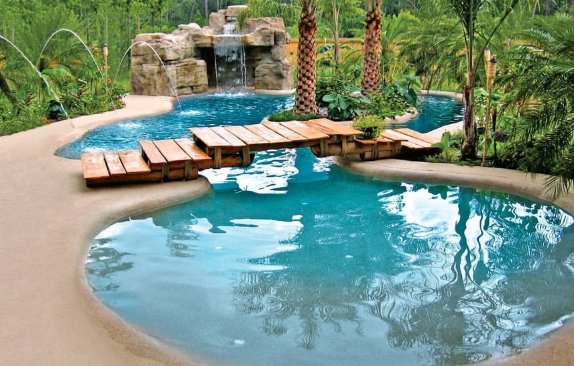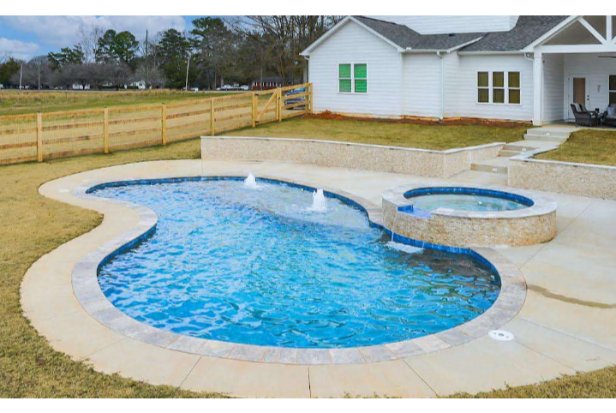What is a Zero-Entry Pool – Pros & Cons You Should Know
One of the most widely used modern designs for luxury pools is the zero-entry pool.
A zero-entry pool might be the perfect option for you if you’re interested in owning a beautiful pool with both aesthetic and practical advantages. This month’s article will teach you everything there is to know about zero-entry pools.
What is a Zero-entry Pool?
Swimming pools with zero entry, also referred to as “beach-entry pools” or “walk-in pools,” are distinguished by their sloping entrance. In contrast to conventional pools, zero-entry pools use a slope in place of heavy stairs and ladders to make the transition from land to water smoother.
Because they mimic the experience of being at the beach, zero-entry pools are frequently called beach pools. Many pool owners decide to encircle the pool with pebbles or sand to improve this effect. In addition, it’s common to include additional water features like rocks or a waterfall.
In a zero-entry pool, the water partially rises up the slope. You don’t immediately immerse yourself in the pool; rather, you gradually do so as you descend the slope to enter it. You can choose to experience the cool water without fully immersing yourself in the pool by simply choosing to stay on the slope.
Is My Yard Suitable for a Zero-entry Pool?
A larger backyard is needed for zero-entry pools than for traditional ones. This is due to the fact that the slope will need to be constructed onto the pool’s side.
The slope must conform to the building code’s 4:1 length-to-height ratio. Consequently, a pool with a 4 foot depth needs to be 16 feet long. If your yard is on the smaller side, you might need to think about reducing the size of your pool if you want a zero-entry design.
There is yet another approach, though. If the slope is only partially steep, you can shorten its length. A partial slope forms a step into deeper water when it stops short of continuing all the way to the pool’s bottom.
What Are the Benefits of a Zero-entry Pool?
The zero entry-pool style offers various aesthetic and functional benefits:
- It’s a unique and attractive pool style that creates a beach atmosphere
- The slope makes it easier for anyone with limited mobility to get into the pool
- The slope provides a shallow area for young children to play in
- The slope is also a great ledge for sunbathing, or for anyone who wants to feel the cool pool water without fully submerging themselves
What Are the Disadvantages of a Zero Entry Pool?
No, not everyone should use zero-entry pools. Before moving forward with the project, be sure to weigh the drawbacks.
- Since zero-entry pools take up more space, they can’t be used in yards with limited space.
- Local animals or pets might use the natural entry to play in or drink from your pool.
- Zero-entry pools are not the best for swimming laps because there is no visible edge.
Are Beach Entry and Zero Entry the Same?
Yes, the two terms are synonymous. Whatever you call them, the pool industry is currently experiencing a major trend. If you haven’t seen one yet, you most likely will in the near future. At a luxurious hotel or water park, you may have visited a beach (or zero) entry pool. A beach entry pool is one where entering feels like entering the ocean even though it is actually an inground swimming pool.
A beach entry pool, also known as a zero entry pool, is an inground swimming pool with an entry that has a very slight slope into the pool, allowing you to enter the water slowly and gradually. On a pool that has a beach entry, the initial entry into the pool begins dry, or with zero water on it, which is where the term “zero entry” pool comes from.

Why is a Zero-Entry Swimming Pool Called a Beach-Entry Pool?
The main justification for calling zero-entry pools “beach-entry pools” is that they make you feel like you’re at the beach in your own backyard. The entrance to the pool should be surrounded by rocks, sand, and beach plants, according to a professional pool designer. The most important thing is that they have at least one sloped side and are walk-in pools.
This would greatly improve the beach effect, making your swimming pool much more aesthetically pleasing. Even using pebbles or chutes is advised by some pool designers.
A zero-entry pool’s water level typically rises due to the slope. As a result, when you get in the pool, you get a soothing immersion. In contrast, you would instantly be submerged in traditional swimming pools.
Therefore, the decision to swim or stay on the slope to enjoy the pool water is entirely up to you.
Will a Zero Entry Pool Fit in My Backyard?
Most likely, but you might need a beach and a standard entry combined. The slope ratio for zero-entry pools cannot be greater than 1:7, as per the International Swimming Pool and Spa Code. The pool can only be one foot deep, or seven feet apart. Residential beach entry fiberglass pools typically combine a sloping beach entry and conventional steps because space for inground swimming pools can be scarce in the majority of people’s backyards. Up until a certain point, they frequently have a beach entry, and then with a few steps down, they transition to the full depth of the pool.
Are Beach Entry Fiberglass Pools ADA Compliant?
They’re not, but they can undoubtedly make entry and exit much simpler for kids, seniors, or anyone else who might find it difficult to use stairs normally. The maximum slope ratio required by the ADA is 1:12, and it must continue to a depth of 30 inches (or, if less, to the pool’s maximum depth).) The ADA handrail and landing requirements would also be applicable.
Why Should You Choose a Zero-Entry Pool over Traditional Ones?
Smart pools are a requirement for smart homes. And we bet you won’t find another innovative yet beautiful pool like a slope-designed pool. The unique style gets you some practical yet fantastic benefits:
- The unique and stylish design gives beach vibes
- Anyone with low mobility can get into the pool, thanks to the slope
- The slope creates an external area where kids can play in
- A zero-entry pool is an excellent opportunity for sunbathing
This zero-entry pool design is quite practical for people who enjoy pool water but don’t want to fully immerse themselves. Unless you have lakefront property, beach entrance pools are the closest thing to the real thing, and even then, who wants to swim in a gross lake?
Is It Difficult to Keep a Zero-Entry Swimming Pool Clean?
A zero-entry pool is much easier to get dirty than a regular pool. Additionally, calling a specialist every week isn’t the best course of action in this case.
We’re here to offer you some advice on how to maintain your opulent pool’s cleanliness by using the simplest techniques.
Get Rid of Floating Debris
Your pool’s filter is prone to becoming clogged with debris. It is therefore best for you to acquire a pool net and remove the floating trash. To keep your pool clean and inviting, try doing this daily. With beach-style pools, frequent barefoot usage will introduce more debris than usual. Regular net fishing will help.
Killing the Germs
It’s necessary to shock the pool in order to get rid of the germs. To shock the pool means to raise the chlorine concentration from 8 to 15 ppm. This technique makes it simple to remove bacteria, algae, and other organic matter.
Be sure to perform this action at night. Since chlorine contains stabilizers, it can be exposed to sunlight and burn the pool’s side corners. You probably also want to know how long after shock you can swim. The answer is that you should wait 24 hours.
Use Brushes to Scrub the Pool
The best course of action in this case would be to clean the pool on your own to save money on professional services. You can scrub the pool’s walls and floors with a pool brush until all the dirt, stains, and germs are removed.
Clean the Pool Filter
Undoubtedly, one of the trickiest steps is cleaning the filter. In order to clear the water, turn on the filter and wait between two and five minutes. Before you get the texture free of stains and dirt, you may need to clean the filter several times. Consider cleaning the filter whenever you notice it producing 10 PSI or more than you expected.
Balancing the Pool Water
Your zero-entry swimming pool’s chemical level must be regularly checked, and you must add the required chemicals whenever a lapse is discovered. Although you should adjust if you’re using any pool chlorine substitutes, the chlorine concentration needs to be between 1 and 5 PPM, the pH needs to be between 7.2 and 7.6, and the stabilizer concentration shouldn’t be less than 30 to 50 ppm.
Pool Cover is Life-Saving
When you are finished using the pool, cover it with a plastic pool cover. Dust, debris, and leaves won’t be able to enter the pool because of the cover. Otherwise, maintaining the pool’s bottom will be extremely challenging.
Debris can also be reduced if you have some awnings you can pull over the pool. To prevent kids and animals from falling into the water because they are attracted to the beach pool design, a pool cover is still necessary.
Changing the Filter
If you want to keep the water clean, changing the filter every so often is necessary. When you notice that the aforementioned suggestions aren’t working, you should change the filter.
Pool Leaks Are a Big No-No
Check to see if your pool has any leaks. Pool leaks result in lost water, a lack of chemicals, and structural problems. Additionally, it is the biggest challenge to maintaining a pool clean, particularly one with a beach entrance.
The Accessories
When you clean the pool in your zero-entry pool, you must wash the accessories you use to make it feel more like the beach. Cleaning the rocks with detergent is another option. Think about occasionally switching out the sand as well.
Conclusion
In order to give the impression that your pool is part of a beach, a zero-entry is primarily used to help achieve this look. Some zero-entry pools may even have waterfalls, sand, and other natural features that give the impression that you are on a real beach.
